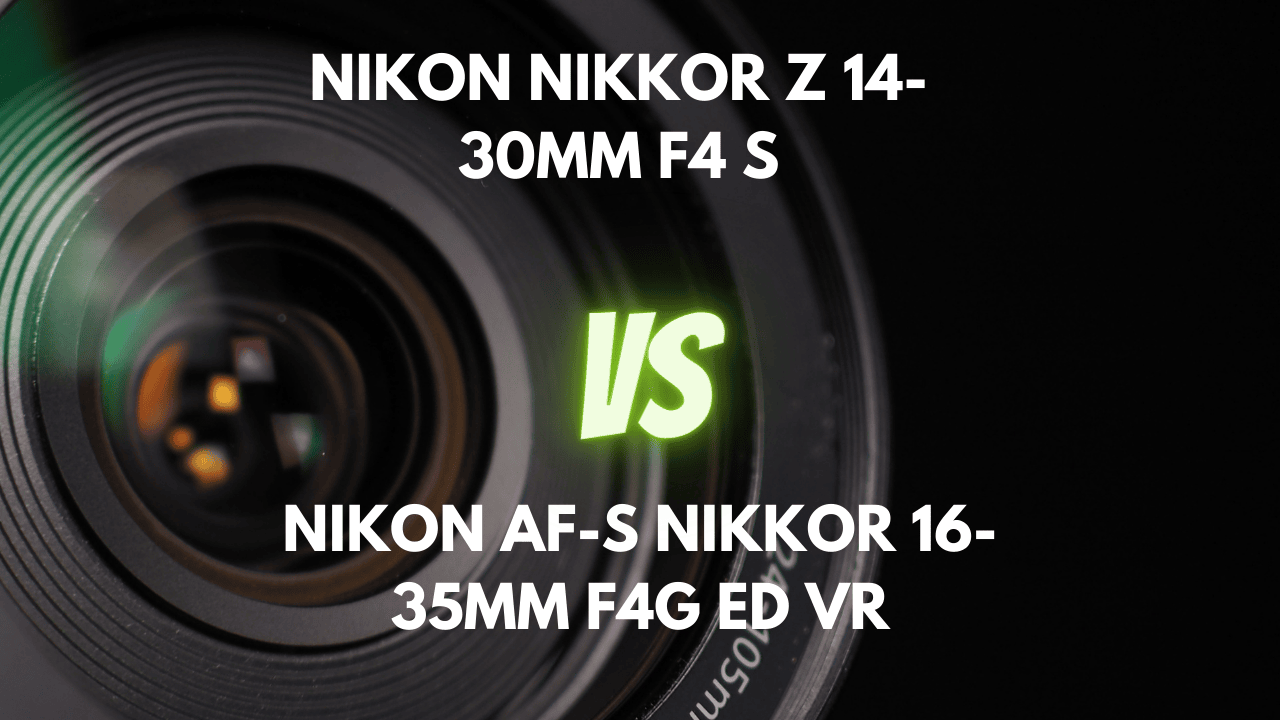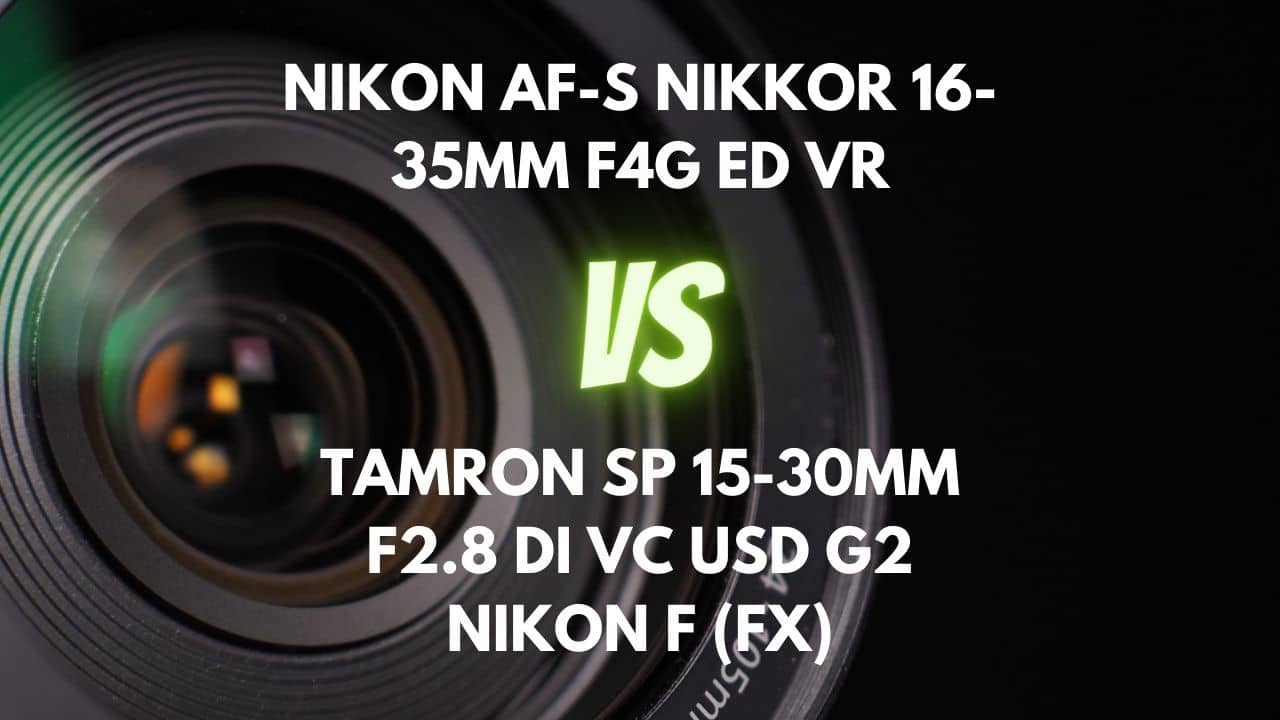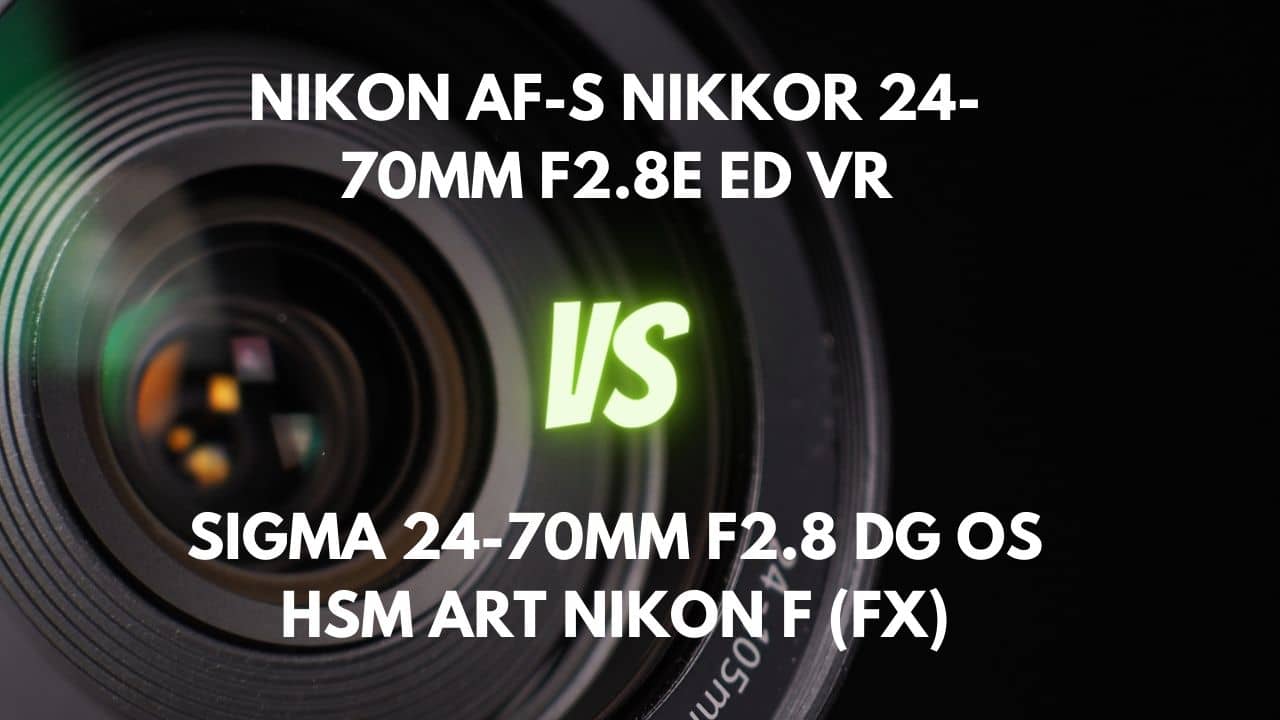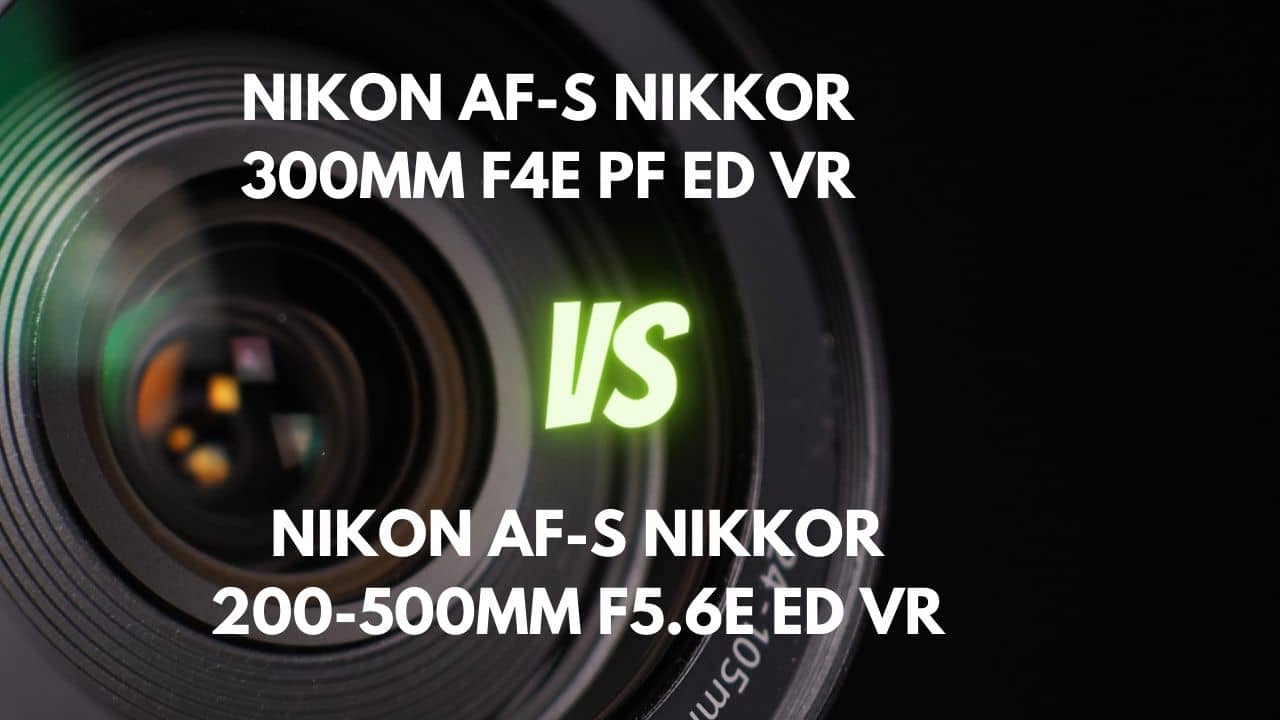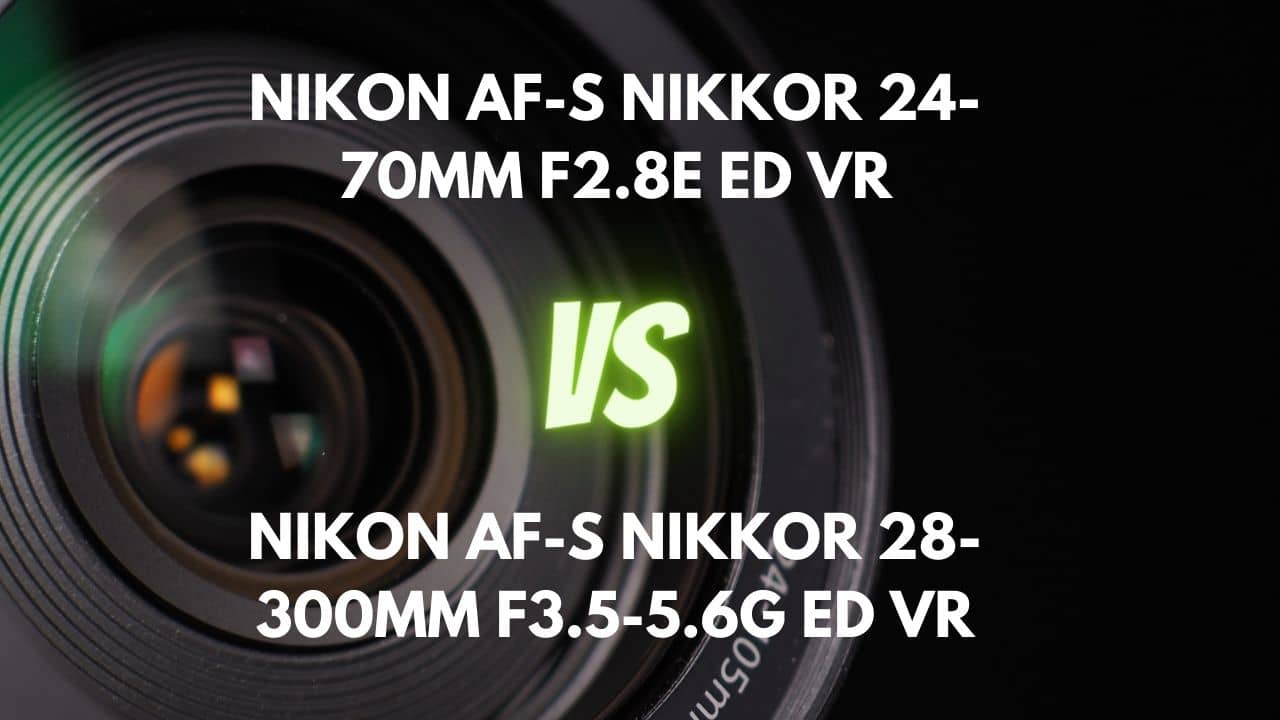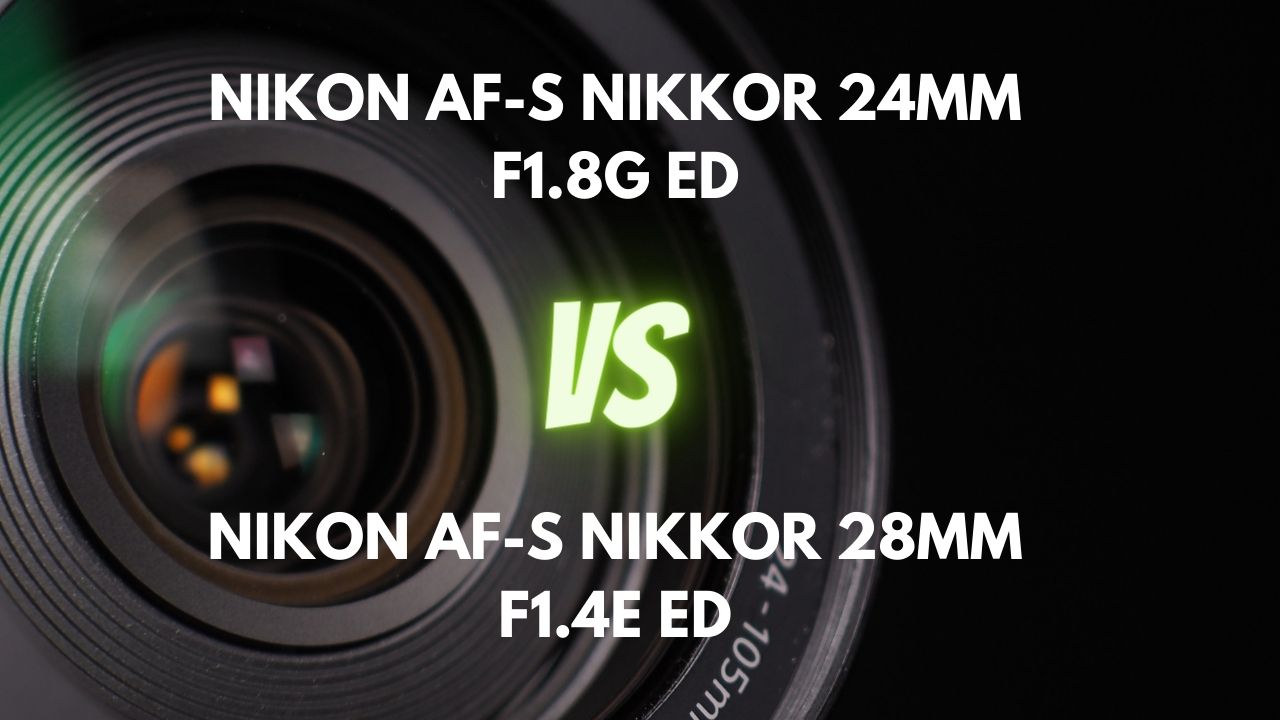Welcome to our exciting head-to-head comparison of two remarkable Nikon lenses: the ultra-wide-angle Nikon AF-P DX NIKKOR 10-20mm F4.5-5.6G VR and the versatile Nikon AF-S DX NIKKOR 35mm F1.8G prime lens.
As photographers, we’re always on the hunt for the perfect lens to capture our world in stunning detail. But with so many lenses on the market, how do we know which one is best suited for our needs?
In this article, we’ll dive deep into the performance of these two popular Nikon lenses, examining their strengths and weaknesses across various aspects such as sharpness, bokeh quality, flare and ghosting control, vignetting, and distortion.
Whether you’re a landscape enthusiast seeking expansive vistas or a portrait lover craving buttery-smooth bokeh, our comprehensive comparison will guide you in making an informed decision on which of these two lenses deserves a place in your camera bag.
So, let’s embark on this photographic journey and discover the perfect lens to unleash your creative potential!
Overview
| Nikon AF-P DX NIKKOR 10-20mm F4.5-5.6G VR | Nikon AF-S DX NIKKOR 35mm F1.8G | |
|---|---|---|
| Max Aperture | F4.5-5.6 | F1.8 |
| Aperture Type | Variable | Fixed |
| Focal Range (mm) | 10-20 | 35 |
| Zoom Ratio (X) | 2 | 1 |
Diving into the world of Nikon lenses, let’s explore the Nikon AF-P DX NIKKOR 10-20mm F4.5-5.6G VR and Nikon AF-S DX NIKKOR 35mm F1.8G
The Nikon DX 10-20mm f/4.5-5.6 is a variable aperture lens with a focal range of 10-20mm, offering a 2x zoom ratio. Its maximum aperture ranges from f/4.5 to f/5.6, depending on the focal length. This lens is more suitable for landscape photography due to its wider focal range, allowing you to capture expansive scenes. It’s worth noting that the Nikon AF-S 16-35mm f/4 lens has a variable aperture, which may lead to slightly reduced image quality and low light performance in comparison to lenses with a fixed aperture.
On the other hand, the Nikon DX 35mm f/1.8 is a fixed aperture lens with a focal length of 35mm, offering a 1x zoom ratio. With a maximum aperture of f/1.8, this lens performs better in low light situations, allowing for faster shutter speeds and lower ISO settings. This lens is more suitable for portrait and street photography due to its focal length. Furthermore, it is cheaper than the 10-20mm lens, making it an attractive option for those on a budget.
If you are interested in landscape photography and need a wider focal range, the Nikon DX10-20mm f/4.5-5.6 would be the ideal choice. However, if you prioritize low light performance, consistent image quality, and are looking for a more affordable lens suitable for portrait and street photography, the Nikon DX 35mm f/1.8 is the better option.
Lens Mount and Barrel
The Nikon DX 10-20mm f/4.5-5.6 boasts a plastic lens mount, making it lightweight and more affordable. While it lacks a rubber gasket for moisture and dust protection, its entry-level nature and five-year warranty ensure you won’t have to worry too much about its durability. The lens barrel, made of polycarbonate plastic, offers portability and ease of use with a wide zoom ring and thin manual focus ring. Though not as finely crafted as pricier options, the barrel’s ergonomic design still serves its purpose.
On the other hand, the Nikon DX 35mm f/1.8 showcases a heavy-duty metal lens mount, offering longevity and protection against the elements with a rubber gasket. Its lens barrel, a mix of hard polycarbonate and plastic parts, strikes a balance between professional and budget-friendly construction. Despite lacking a focus distance scale and vibration reduction feature, Nikon doesn’t compromise on the overall build quality.
Design and Ease of Use
| Nikon AF-P DX NIKKOR 10-20mm F4.5-5.6G VR | Nikon AF-S DX NIKKOR 35mm F1.8G | |
|---|---|---|
| Diameter x Length (mm) | ⌀77×73mm | ⌀70×52.5mm |
| Weight (gr) | 230 | 200 |
| Filter Thread (mm) | 72 | 52 |
| Weather Sealing | No | No |
| Zoom Method | Rotary (extending) | No Zoom |
| Distance Scale | No | No |
| DoF Scale | No | No |
| Hood Code | HB-81 | HB-46 |
The Nikon DX 10-20mm f/4.5-5.6 is a wide-angle lens with dimensions of ⌀77×73mm and a weight of 230 grams. It has a 72mm filter thread and features an extending rotary zoom method. Its larger dimensions and weight make it less portable, and the extending zoom method may impact weather sealing and balance while shooting.
On the other hand, the Nikon DX 35mm f/1.8 is a prime lens with dimensions of ⌀70×52.5mm and a weight of 200 grams. It has a 52mm filter thread and no zoom capability. Its smaller size and lighter weight make it more portable and discreet, allowing you to capture candid shots without drawing too much attention. The absence of a zoom mechanism simplifies the design, which could result in increased durability.
If you prioritize a lightweight, compact design with a more affordable price, the Nikon DX 35mm f/1.8, featuring a metal lens mount and mixed-material barrel, might be the perfect fit. This lens offers durability and a professional feel while being easy on your wallet and comfortable to carry around.
On the other hand, if you prefer a wide-angle zoom lens with an ergonomic design and plastic construction, the Nikon DX 10-20mm f/4.5-5.6 could be the way to go. Although not as finely crafted as pricier options, it still provides ease of use and portability.
Weather Sealing
When it comes to weather sealing, the Nikon DX 10-20mm f/4.5-5.6 and the Nikon DX 35mm f/1.8 showcase different levels of protection against the elements. Let’s explore their capabilities in this regard.
The Nikon DX 10-20mm f/4.5-5.6, unfortunately, does not come with weather sealing. This means that it may be vulnerable to dust, moisture, and light water splashes, making it less ideal for photographers shooting in extreme humid or wet environments. The lens is not equipped with gaskets at the lens mount or internal seals at the rings, switches, and front of the barrel, which could potentially make it more susceptible to damage and wear over time.
On the flip side, the Nikon DX 35mm f/1.8 offers a higher level of protection with a generous weather sealing gasket at the lens mount. This design suggests that the lens is weather-sealed to some extent, making it a more suitable companion for outdoor photography in various conditions.
In conclusion, the Nikon DX 35mm f/1.8 outshines the Nikon DX 10-20mm f/4.5-5.6 in terms of weather sealing. Its gasket at the lens mount provides an extra layer of protection against the elements, ensuring better durability and performance in challenging environments. If you often find yourself shooting outdoors and need a lens that can withstand adverse conditions, the Nikon DX 35mm f/1.8 might be your best bet.
Rings
Let’s dive into the design and functionality of the rings on both of them.
The Nikon DX 10-20mm f/4.5-5.6 lens boasts two rings: a large, textured rubber grip zoom ring and a slim manual focus ring. The zoom ring offers easy operation with clear markings at 10, 12, 14, 16, and 20mm, providing a comfortable grip and smooth rotation. The manual focus ring, positioned just behind the front element, is quite narrow, making it somewhat tricky to turn.
Although there is no windowed distance scale or depth-of-field indicator on the focus ring, autofocus can be overridden at any time by simply rotating the focus ring. While the rings are rubberized and smooth, there is no zoom lock switch on the zoom ring.
In contrast, the Nikon DX 35mm f/1.8 features a single focus ring located at the front of the barrel. This plastic ring is covered with rubber, but it feels slightly sticky when rotating. The lens lacks a focus distance scale or depth-of-field indicator, which may be a disadvantage for street photographers. Although the focus ring on the Nikon AF-S 16-35mm f/4 lens shows minimal play when changing focus direction in manual focus mode, a slight image shift can be observed at maximum magnification in Live View. As this lens has a fixed focal length of 35mm, there is no zoom ring.
Switches
Let’s examine the switches on these two lenses to understand their functionality and user experience.
The Nikon DX 10-20mm f/4.5-5.6 lens features a minimalistic design, with no switches on the barrel itself. To change focus modes, users must rely on the switch on their Nikon camera. This could affect compatibility with some Nikon cameras. There is no physical VR (Vibration Reduction) switch either, requiring users to turn off VR in their camera’s menus. While there is no dedicated AF/MF switch on this budget-friendly lens, manual override and fully manual focusing are available via an electronically coupled focus ring.
On the other hand, the Nikon DX 35mm f/1.8 lens is equipped with 2 switches on the barrel. The first switch allows users to toggle between autofocus and manual focus modes. When set to “M/A,” the autofocus function is enabled, allowing users to adjust the focus manually at any time. On the other hand, in the “M” position, the lens remains locked in manual focus mode. This design offers a more user-friendly experience for photographers who prefer direct control over their lens settings.
In conclusion, the Nikon DX 35mm f/1.8 lens has a superior switch design, providing users with greater control over focus modes directly on the barrel. Although the Nikon DX 10-20mm f/4.5-5.6 lens is more minimalistic and budget-friendly, its lack of switches could impact compatibility and user experience. For photographers seeking direct control over their lens settings, the Nikon DX 35mm f/1.8 lens is the better choice.
Filter Thread
Let’s delve into the filter thread differences between the Nikon DX 10-20mm f/4.5-5.6 and the Nikon DX 35mm f/1.8 lenses to understand their practical implications in photography.
The Nikon DX 10-20mm f/4.5-5.6 lens features a 72mm metal filter thread encircling the front element. This design allows for easy use with conventional filters. Additionally, the filter thread does not rotate during autofocus, which simplifies the use of polarizing or graduated filters—a common feature among modern lenses.
On the other hand, the Nikon DX 35mm f/1.8 lens has a 52mm plastic filter thread. This size is consistent with other short Nikkor prime lenses. Despite being made of plastic, the filter thread remains easy to use with filters and does not cause vignetting, even with combinations of thick filters. The filter ring remains stationary and does not rotate or move during focusing, making it convenient for filter usage.
Let’s delve into the filter thread differences between the Nikon DX 10-20mm f/4.5-5.6 and the Nikon DX 35mm f/1.8 lenses to understand their practical implications in photography.
The Nikon DX 10-20mm f/4.5-5.6 lens features a 72mm metal filter thread encircling the front element. This design allows for easy use with conventional filters. Additionally, the filter thread does not rotate during autofocus, which simplifies the use of polarizing or graduated filters—a common feature among modern lenses.
On the other hand, the Nikon DX 35mm f/1.8 lens has a 52mm plastic filter thread. This size is consistent with other short Nikkor prime lenses. Despite being made of plastic, the filter thread remains easy to use with filters and does not cause vignetting, even with combinations of thick filters. The filter ring remains stationary and does not rotate or move during focusing, making it convenient for filter usage.
In conclusion, both lenses offer practical filter thread solutions. The Nikon DX 10-20mm f/4.5-5.6 lens has a larger, more durable metal filter thread, which might be preferable for those who frequently use filters or require additional durability. Meanwhile, the Nikon DX 35mm f/1.8 lens has a smaller, lightweight plastic filter thread that aligns with other Nikkor prime lenses, making it a suitable choice for photographers who already own lenses with similar thread sizes. Choosing the superior filter thread depends on your specific requirements, photography needs, and existing gear.
Lens Hood
Let’s compare the lens hoods to determine which one provides better protection and usability.
The Nikon DX 10-20mm f/4.5-5.6 lens comes with a large petal-type hood made of plastic, included in the box. This bayonet mount lens hood can be easily reversed over the barrel when not in use. The material and finish are of good quality, and it is simple to mount and dismount. Additionally, the hood’s ergonomic bevel design allows for smooth rotation when adjusting the direction of light.
On the contrary, the Nikon DX 35mm f/1.8 lens is accompanied by a plastic bayonet HB-46 hood, included as a standard accessory in most markets but not provided for the test. Although it performs well, it does not block as much light as it could.
In conclusion, the Nikon DX 10-20mm f/4.5-5.6 lens hood seems to be superior due to its larger size, petal-type design, and ergonomic bevel. These features contribute to better light blocking and ease of use. On the other hand, the Nikon DX 35mm f/1.8 lens hood is more basic in its design and functionality, but it still provides adequate protection.
Focusing and Optical Stabilization
| Nikon AF-P DX NIKKOR 10-20mm F4.5-5.6G VR | Nikon AF-S DX NIKKOR 35mm F1.8G | |
|---|---|---|
| Autofocus | Yes | Yes |
| AF Motor | Stepper motor | Silent Wave Motor |
| Min Focus Distance | 0.22m | 0.3m |
| Max Magnification (X) | 0.17 | 0.16 |
| Full-Time Manual Focus | Yes | Yes |
| Focus Method | Internal | Internal |
Focusing Performance
Let’s dive into the focusing performance and determine which one offers superior performance.
The Nikon DX 10-20mm f/4.5-5.6 lens boasts a fast and quiet autofocus, attributed to its AF-P stepper motor. This motor effectively eliminates jitters and shudders when shooting handheld video. The lens can focus accurately, and it offers a convenient manual focus override ring for quick adjustments. With a reasonably fast focusing speed and impressive autofocus acquisition, this lens also performs well in low-light situations. The manual focus action is precise and smooth, but a slight hum may be audible when focusing in quiet environments.
On the other hand, the Nikon DX 35mm f/1.8 lens provides smooth, fast, and quiet autofocus when using the optical viewfinder. However, when switching to Live View, the lens hunts back and forth before locking focus. The autofocus is based on a ring-type ultrasonic system, and it includes the usual full-time manual override via a mechanically linked focus ring. This lens may not be ideal for manual focus video due to the noise generated as it turns.
In conclusion, the Nikon DX 10-20mm f/4.5-5.6 lens appears to have a superior focusing performance due to its fast, quiet autofocus, convenient manual focus override, and impressive low-light capabilities. Although the Nikon DX 35mm f/1.8 lens performs well with the optical viewfinder, its limitations in Live View and manual focus noise during video recording make it less versatile compared to the Nikon DX 10-20mm f/4.5-5.6 lens.
Optical Stabilization
Let’s compare the optical stabilization to determine which one offers better performance in this aspect.
The Nikon DX 10-20mm f/4.5-5.6 lens features built-in optical stabilization, which Nikon claims can allow you to shoot at shutter speeds 3.5 stops slower than would otherwise be possible without causing blurring due to camera shake. This feature is effective for handheld shooting in lower light conditions compared to using a larger-aperture lens. The vibration reduction (VR) operates silently, enabling shooting at slower shutter speeds, typically around 1/10 of a second, and even as slow as 1/6 of a second. However, slower shutter speeds may yield mixed results.
In contrast, the Nikon DX 35mm f/1.8 lens does not have optical stabilization. While wide-angle lenses like the Nikon DX 35mm f/1.8 generally don’t require stabilization as much as telephoto lenses due to their shorter focal lengths and wider field of view, optical stabilization can still be beneficial in low light conditions, at slower shutter speeds, or when recording video.
Image Quality
| Nikon AF-P DX NIKKOR 10-20mm F4.5-5.6G VR | Nikon AF-S DX NIKKOR 35mm F1.8G | |
|---|---|---|
| Special Elements | 3 aspherical + Super Integrated Coating | 1 ASPH |
| Diaphragm Blades | 7 | 7 |
Aberration
Let’s compare the aberration performance to find out which one handles chromatic aberration better.
The Nikon DX 10-20mm f/4.5-5.6 lens exhibits noticeable chromatic aberration, particularly near the edges of the frame when shooting wide open at 10mm. However, most of this aberration is effectively removed by the compatible cameras’ JPEG engines, and it can also be corrected in post-processing. The lens does not have a significant issue with coma, but spherochromatism can cause colored fringes on out-of-focus highlights in some situations, although it is not a major problem.
Let’s compare the aberration performance of the Nikon DX 10-20mm f/4.5-5.6 and the Nikon DX 35mm f/1.8 lenses to find out which one handles chromatic aberration better.
The Nikon DX 10-20mm f/4.5-5.6 lens exhibits noticeable chromatic aberration, particularly near the edges of the frame when shooting wide open at 10mm. However, most of this aberration is effectively removed by the compatible cameras’ JPEG engines, and it can also be corrected in post-processing. The lens does not have a significant issue with coma, but spherochromatism can cause colored fringes on out-of-focus highlights in some situations, although it is not a major problem.
At f/4 and narrower apertures, there is a possibility that the corners of the frame may exhibit lateral chromatic aberration when using the Nikon DX 35mm f/1.8 lens. However, this aberration is automatically corrected in-camera by current and recent Nikon DSLRs. While longitudinal chromatic aberration can occasionally be problematic, particularly in out-of-focus areas, it is not a common issue. While using the f/1.8 aperture on your lens, you may notice a slight green tinge in out-of-focus highlights in the background and a magenta tinge in the foreground due to spherochromatism, but the effect is not significant.
In conclusion, both lenses exhibit some degree of chromatic aberration and spherochromatism. However, the Nikon DX 35mm f/1.8 lens have better aberration performance, as its issues are automatically corrected in-camera or are not very noticeable.
Sharpness
Let’s dive into the sharpness performance to determine which one delivers superior image clarity.
The Nikon DX 10-20mm f/4.5-5.6 lens offers good to very good sharpness performance, with even performance at 10mm from wide open up to f/14, and peaking at around f/8-f/11 at other focal lengths such as 12, 14, 16, and 18mm. The edge and corner sharpness can be somewhat lackluster and a little poor at 20mm, but the center sharpness is very good even when shooting wide open throughout most of the zoom range. However, sharpness is affected by diffraction at f/11 and smaller apertures.
The sharpness of the Nikon DX 35mm f/1.8 lens is quite remarkable, even at its widest aperture of f/1.8. While the center is the sharpest at f/4 and f/5.6, images remain highly sharp between f/2 to f/11. When it comes to edge sharpness, the best results are achieved between f/2.8 to f/8, with a similar trend to the center. Although the lens exhibits impressive sharpness across the entire image frame from f/2.8 to f/8, it may fall a bit short when used wide-open at f/1.8, especially towards the edges of the frame. The lens is so sharp that it easily excites aliases and performs well in various situations. Stopping down from f/1.8 to f/2 slightly improves sharpness, while at f/2.8, the lens is much sharper than f/2. The sharpest apertures are at f/4 and f/5.6.
In conclusion, the Nikon DX 35mm f/1.8 lens demonstrates superior sharpness performance compared to the Nikon DX 10-20mm f/4.5-5.6 lens. With impressive sharpness across the whole image frame and excellent performance at various apertures, the Nikon DX 35mm f/1.8 lens stands out as the better choice if sharpness is a key priority for your photography.
Bokeh Quality
Let’s explore the bokeh quality to determine which one delivers a more pleasing background blur.
The Nikon DX 10-20mm f/4.5-5.6 lens produces a restrained and subjectively good bokeh. However, as an ultrawide-to-wide zoom lens with a slow aperture, achieving substantial bokeh can be rare and sometimes nervous. Despite these limitations, the lens’ bokeh quality is decent and can be achieved through careful subject selection, camera settings, and composition.
On the other hand, the Nikon DX 35mm f/1.8 lens has fair to poor bokeh wide open, but it improves slightly when stopped down. If the background is fairly homogeneous, you can achieve very smooth bokeh with virtually any lens. However, lens design becomes more critical when dealing with less cooperative backgrounds.
Taking into consideration the primary use of the Nikon DX 10-20mm f/4.5-5.6 lens for landscape photography, where sharp images are prioritized over blurred backgrounds, bokeh quality may not be as important for this lens as it is for the Nikon DX 35mm f/1.8 lens.
The 10-20mm lens still has the ability to produce pleasant bokeh in certain situations, but its main strength lies in capturing sharp, wide-angle images. On the other hand, the Nikon DX 35mm f/1.8 lens is more suitable for those seeking better subject separation and smoother background blur.
Flare/Ghosting
The Nikon DX 10-20mm f/4.5-5.6 lens excels in managing flare and ghosting, displaying minimal reduction in contrast or the creation of artifacts in images. Remarkably, this lens outshines even the fixed prime FX Nikkor 20mm AF-S f/1.8 lens when the sun is within the frame. Additionally, side light hitting the front glass doesn’t pose a significant issue.
On the other hand, the Nikon DX 35mm f/1.8 lens features Nikon’s Super Integrated Coating, which helps minimize ghosting and flare. However, moderate flaring may still be visible when bright lights are present in the image.
In conclusion, the Nikon DX 10-20mm f/4.5-5.6 lens has a superior performance in handling flare and ghosting compared to the Nikon DX 35mm f/1.8 lens. This attribute is particularly beneficial for landscape photographers, as it allows them to capture high-quality, clear images even in challenging lighting situations.
Vignetting
The Nikon DX 10-20mm f/4.5-5.6 lens experiences noticeable vignetting, particularly at 10mm when shooting wide open. However, this issue improves at 15mm and 20mm focal lengths. Though most pronounced at 10mm, vignetting can be corrected using post-processing software programs. In real-life situations, it is less problematic than it might seem in sample images.
On the other hand, the Nikon DX 35mm f/1.8 lens displays moderate vignetting in the image corners at f/1.8, but it is not a significant concern. If in-camera corrections are turned off or if shooting in raw mode, the darkening effect becomes more apparent. Nevertheless, this effect is not field relevant and can be easily rectified during post-processing if necessary.
In conclusion, the Nikon DX 35mm f/1.8 lens has a slight edge over the Nikon DX 10-20mm f/4.5-5.6 lens in terms of vignetting performance. While both lenses exhibit some level of vignetting, the Nikon DX 35mm f/1.8 lens’s effect is less pronounced and easier to manage, providing photographers with more evenly illuminated images.
Distortion
The Nikon DX 10-20mm f/4.5-5.6 lens exhibits barrel distortion, which is most pronounced at its shortest focal length of 10mm, measuring at 3.55%. As you zoom in, the distortion decreases and becomes almost non-existent at the longer end. In real-world shooting, distortion isn’t a major issue and can be corrected in-camera for JPGs or through software like Lightroom Classic for RAW format. However, for those seeking great results straight out of the camera, some correction may be required.
The Nikon DX 35mm f/1.8 lens exhibits a noticeable amount of barrel distortion, measuring around 2.3 percent. The distortion level exhibited by the lens is relatively high for a standard-angle prime lens, and it has the potential to cause some slight curvature of straight lines in images. However, in most shooting scenarios, this distortion may not be easily noticeable. In-camera adjustments can correct distortion when shooting JPGs, but this may slightly alter the angle of view in your photos. Photoshop’s lens distortion filter is another option for correcting the barrel distortion, especially at its widest setting.
In conclusion, the Nikon DX 35mm f/1.8 lens has a slight advantage over the Nikon DX 10-20mm f/4.5-5.6 lens in terms of distortion performance. Although both lenses experience some level of barrel distortion, the Nikon DX 35mm f/1.8 lens exhibits a lower percentage, making it less likely to impact image quality for photographers who prefer minimal post-processing.
Final Verdict
After comparing the Nikon DX 10-20mm f/4.5-5.6 and Nikon DX 35mm f/1.8 lenses across various factors, it’s clear that each lens has its own strengths and weaknesses.
The Nikon DX 10-20mm f/4.5-5.6 lens excels in flare and ghosting control and offers good sharpness performance throughout most of its zoom range. It has noticeable distortion at 10mm, but it is not a significant issue in real-world shooting. This lens is primarily designed for landscape photography, where sharp images are more important than bokeh quality.
The Nikon DX 35mm f/1.8 lens delivers impressive sharpness, even wide-open at f/1.8, with optimal sharpness at f/4 and f/5.6. It has better bokeh quality and less distortion than the Nikon DX 10-20mm f/4.5-5.6 lens, but it may exhibit some flare and ghosting when bright lights are present in the picture.
In conclusion, the choice between these two lenses depends on your specific photography needs. If you’re primarily into landscape photography and require wider focal lengths, the Nikon DX 10-20mm f/4.5-5.6 lens would be more suitable. However, if you’re looking for a versatile prime lens with better bokeh quality and less distortion, the Nikon DX 35mm f/1.8 lens would be the better option.

